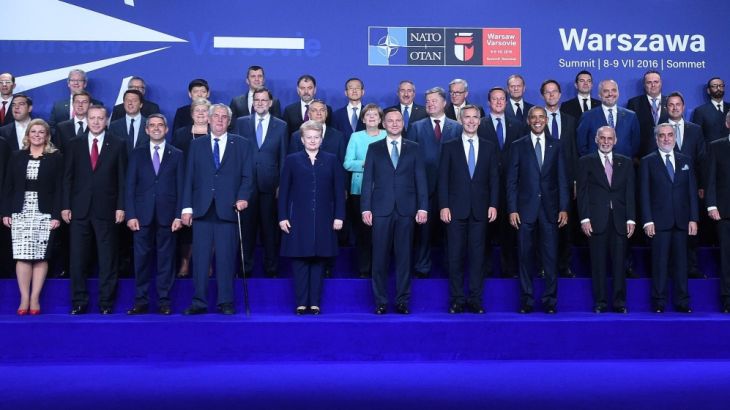NATO leaders discuss perceived Russian threats
Alliance to deploy four battalions totalling 3,000 to 4,000 troops in move to secure Baltic states from Russia.

NATO leaders have begun a key summit in Polish capital Warsaw to bulk up European defence against a perceived Russian threat to Baltic states and Poland.
Jens Stoltenberg, NATO’s secretary-general, said the summit will order changes in the alliance “so our people are safe, our countries are secure and our values are preserved”.
Keep reading
list of 4 itemsNATO allies must do more as Ukraine runs out of ammunition: Stoltenberg
Nordic tensions on the rise amid Russian anger over NATO accessions
Flag of NATO’s 32nd member, Sweden, raised at alliance’s headquarters
“The decisions we’re going to take together will once again confirm that Europe and North America stand together, act together to support all allies against any threats,” Stoltenberg said on Friday.
‘Open for dialogue’
Shortly before the summit began, leaders of the NATO and the European Union signed a “historic deal” that boosts their cooperation in defence against a variety of security threats faced by their nations and citizens, in an apparent reference to Russia’s seizure of Crimea from Ukraine.
After arriving in Warsaw, Obama announced the US will send an additional 1,000 US. troops to Poland as part of a NATO effort to reinforce its presence on the alliance’s frontiers near Russia.
He met Polish President Andrzej Duda, and hailed Poland as “a linchpin in the defence of NATO’s eastern flank.”
Stoltenberg said for NATO’s 28 member nations to be safe, they don’t only need to reinforce their own armed forces, but to come to the aid of partner nations in the Middle East and North Africa menaced by violence.
The alliance will formally agree to deploy four battalions totalling 3,000 to 4,000 troops in the Baltic states and Poland on a rotating basis to reassure eastern members of its readiness to defend them against any Russian aggression.
“For our nations to be safe, it’s not enough to keep our defences strong, we must help to make our partners stronger,” Stoltenberg said.
Among the items on the NATO meeting’s ambitious agenda is increased assistance for Iraq’s military, extension of the West’s financial commitment to the Afghan military and police, aid for Tunisia, and getting NATO more involved in the campaign against the Islamic State of Iraq and the Levant (ISIL) group.
![About 2,000 delegates, including 18 heads of state, 21 prime ministers, 41 foreign ministers and 39 defence ministers will take part in the summit. EPA/RADEK PIETRUSZKA POLAND OUT [-]](/wp-content/uploads/2016/07/cb1ba2eab29e4b5d903d252967f42c23_18.jpeg)
In Warsaw, NATO heads of state and government will also formally order deployment of multinational units on the alliance’s eastern borders. The action, telegraphed in advance like most items on the summit programme following months of deliberations by NATO member governments, is vigorously opposed by the Kremlin.
A spokesman for Russian President Vladimir Putin said Moscow is willing to cooperate with NATO, even though he said it acts towards Russia like an enemy.
Russia “has always been open for dialogue” with NATO, especially to fight what it sees as a “genuine threat” – terrorism, Dmitry Peskov said.
“Russia is not looking [for an enemy] but it actually sees it happening,” Peskov told reporters in Moscow. “When NATO soldiers march along our border and NATO jets fly by, it’s not us who are moving closer to the NATO borders.”
Is Russia really a threat to the Baltic states?
Estonia, Latvia, Lithuania and Poland – all NATO members – have requested a permanent NATO presence.
They fear Moscow will seek to destabilise their pro-Western governments through cyber attacks, stirring up Russian speakers, hostile broadcasting and even territorial incursions.